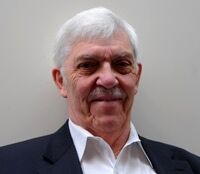
From Brushwork to Buildings, Classrooms to Criticism

by Troy Pieper (MA 2015)
When he graduated from the University of Chicago in 1945 with a bachelor's degree in philosophy, Franz Schulze (BFA 1949, MFA 1950) thought, “What am I going to do with this?” He always had a bit of an interest in art, and he thought he might make a good graphic designer, so he turned to the School of the Art Institute of Chicago (SAIC). It turned out that painting was where his true interests lie. One of the best parts about studying at SAIC, he says, was the presence of the Art Institute and its collection. “I can remember being in some studio class sometimes and something wouldn’t be working, and we’d walk over to the Art Institute. Family at Saltimbanquesby Picasso…that was where you found out how to paint!”
Schulze earned a BFA and MFA from the School, but that was only the beginning of the artist, writer, and teacher’s 70-year path through Chicago’s art world. That path has led him to many things over the years, including the honorary doctorate degree the school awarded him at SAIC’s Commencement Ceremony this year.
Schulze plunged into the local art scene as a student at SAIC, when he joined a group of activist art students protesting the Art Institute of Chicago. The Institute’s annual Chicago and Vicinity exhibition had decided to exclude student work in the 1948 show, and students at SAIC and the Institute of Design formed Exhibition Momentum, a group that held its own exhibition in protest of the museum’s decision.
The action worked; the Art Institute readmitted student work to the exhibition the following year, but the group continued to hold exhibitions until the 1960s. Those shows were juried—sometimes by New York artists like Jackson Pollock and Robert Motherwell, who wanted to “see what was going on in Chicago,” Schulze says. He has had several exhibitions of his paintings over the years, despite being inclined toward realism and naturalism, “although I knew that was not the way to go,” Schulze quips. “In those days abstraction meant more than being a realist did, but I couldn’t help being a realist.”
After receiving his MFA, Schulze needed a job. He had learned a good deal about commercial design and layout by then, and he was hired by famed industrial designer Raymond Loewy as a graphic designer. He soon found that being “low on the totem pole” did not bring him a lot of interesting work, and when he heard that teaching only required 18 hours of work per week, he applied to teach art at Purdue University. “But that was just the time in class,” Schulze laughs. “At the same time, I liked teaching well enough that I continued with it.”
After a couple of years at Purdue, Schulze became Professor of Art and head of the Art Department at Lake Forest College, where he taught for 40 years. He continued to paint while teaching, but at a certain point, he turned to writing. “There were many of us in Chicago who felt very strongly about art and that there was a Chicago point of view which needed attention,” he recalls. He put down his brush to begin writing forARTnews and the Chicago Daily News about what was happening in the art world in his city. Many of those articles developed into Fantastic Images: Chicago Art since 1945, a book in which he coined the term “Chicago Imagism.” The uniquely Chicago movement preferred representational art in which “the human form was the central figure, the main motif. It had a view toward subject matter and expressed some sort of a feeling or mood,” says Schulze.
He also wrote for the Chicago Sun-Times, Art in America, and others, as well as authoring a biography of world-famous architect Ludwig Mies van der Rohe and other books about architecture. Of late, Schulze is back to painting and making portraits of Chicago architects and Lake Forest College friends and colleagues. The college will hold an exhibition of his work this fall.
The variety of Schulze’s interests in art and his passion for each one reflect the nature of the institution that was his gateway into the art world. “The great thing about SAIC is that there were many points of view, and none of them was proscribed,” he says. “Everybody there was deeply involved in the school and the Chicago art scene, and the universality of the students and faculty was very important.” He notes that at the time the school was not nearly as well known as it is today. “In some sense I’m honored by how its reputation has grown since then.”
